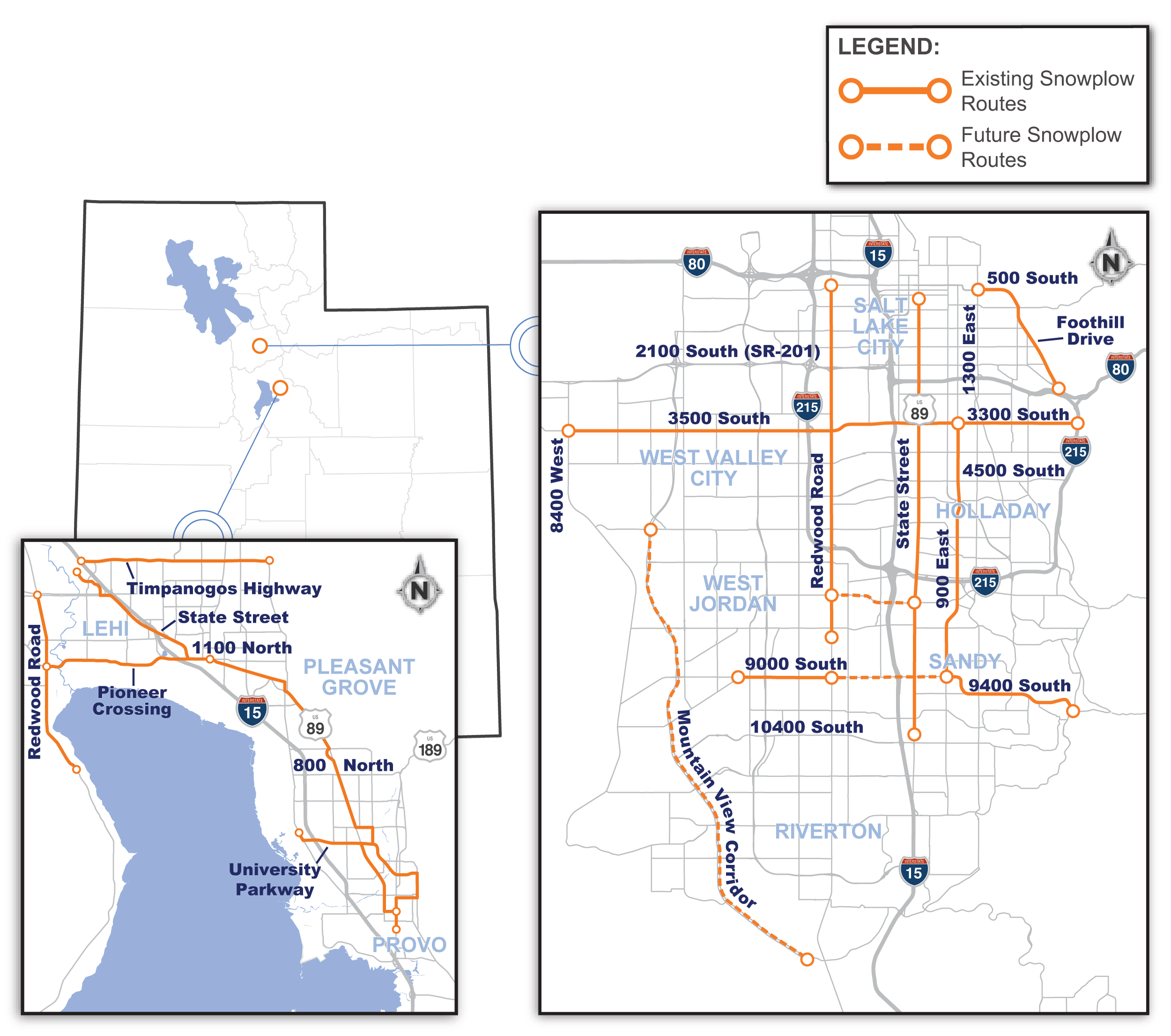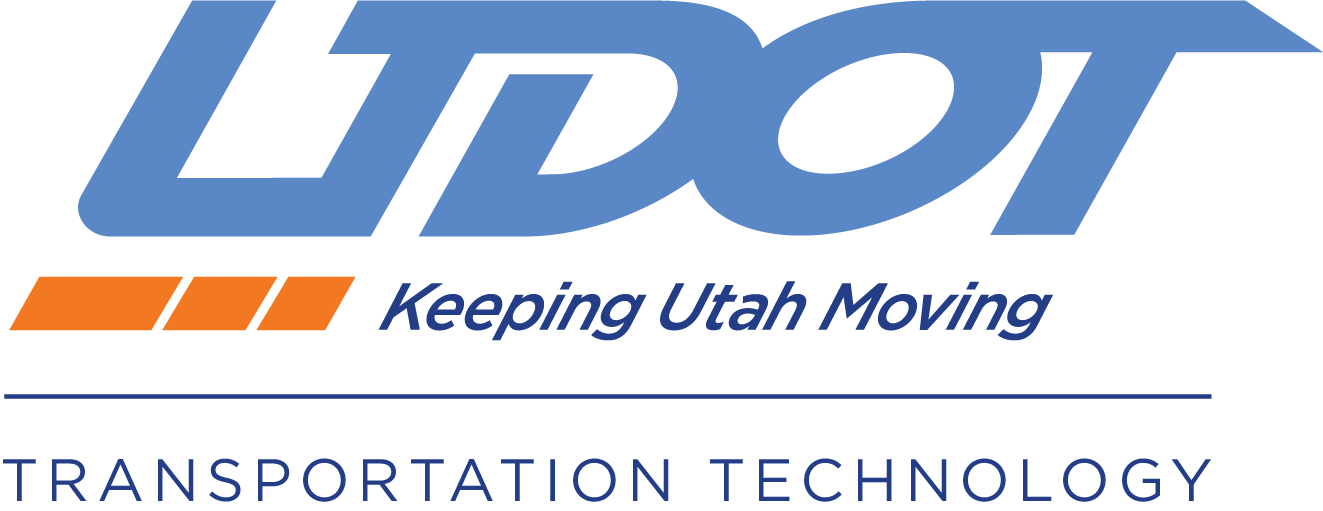Snowplow Preemption
Quick and efficient removal of snow from our roadways is a key to safety. Connected snowplows can request signal preemption at intersections where the vehicle is actively plowing snow. This allows the plow to keep moving through the intersection. Efficient use of snow plow operations can significantly reduce crashes along urban corridors.
OVERVIEW
UDOT’s Snow plow Preemption Project utilizes “vehicle-to-everything” (V2X) wireless technology to enable snowplows that are actively plowing to preempt an upcoming traffic signal, meaning that the red light will turn to green to allow the plow to move through the intersection. This allows plowing operations to be more efficient, removing the snow and ice from our roadways sooner. Snow plows are equipped with onboard units that use V2X wireless technology to send and receive messages from traffic signals that are equipped with similar technology.
The TSP and the Snow Plow Preemption Project do differ in some ways. TSP provides conditional priority to a bus that is behind schedule and extends an existing green light, whereas the Snow Plow Preemption anticipates the snowplow coming and changes a red light to green to keep the plow moving at efficient speeds.
BENEFITS OF THE TECHNOLOGY
Utah winter weather can make road conditions dangerous, so quick and efficient removal of snow and ice from roadways is key to maintaining safe road conditions. A study conducted by UDOT in 2018 on five urban corridors in the Salt Lake Valley concluded that up to 89 crashes occur each year due to snowy, icy, or slushy roads. These conditions can be mitigated sooner by improving the efficiency of snow plow operations, hopefully reducing crashes.
QUICK FACTS
“Safety is greatly
enhanced on five urban
corridors through
incorporating connected
vehicle signal preemption
into snowplow
operations.”
The Snow Plow Preemption Project is designed to heighten the effectiveness of snow removal on roads, thus keeping Utahns safe by reducing crashes caused by winter weather conditions. Studies are underway to measure the benefits.
WHERE THE TECHNOLOGY IS DEPLOYED
The program has been deployed on five corridors in the Salt Lake Valley and uses 46 snowplows equipped with V2X technology. The following are specific routes where it has been deployed:
- Foothill Boulevard from 400 South to I-80. This corridor serves as the primary arterial access to the University of Utah and has 9 signalized intersections.
- Redwood Road from 400 South to Bangerter Highway.
- 10400 South from Bangerter Highway to I-15. This is a significant east-west arterial with 11 signalized intersections.
- 700 East and 900 East from 400 South to 9000 South.
- 9000 South and 9400 South from 4000 West to Redwood Road and 700 East to Wasatch Boulevard at the mouth of Little Cottonwood Canyon. This is a major east-west arterial leading to significant roadways and two ski resorts, and it has 21 signalized intersections.
This system has also been deployed in the Provo-Orem area of Utah County, along the route of the Utah Valley Express (UVX) bus. The 47 intersections along this route already had V2X equipment installed as part of the TSP system deployed in 2018. V2X equipment was also installed in six UDOT snow plows.
UDOT is planning to implement additional Snowplow Preemption locations in Salt Lake County, including:
- Wasatch Boulevard from I-215 to Little Cottonwood Canyon. This is a significant route serving major recreational areas, with 8 signalized intersections.
- 7000 South and 7200 South from Redwood Road to State Street. This east-west corridor connects to I-15, with 7 signalized intersections.
- Mountain View Corridor from Redwood Road to 5400 South. This divided arterial provides north-south service on the west side of the Salt Lake Valley and has 12 signalized intersections (each intersection has two signals).
- Redwood Road from 12300 South to Porter Rockwell. This is a continuation of a corridor with 7 additional signalized intersections.
- State Street from 400 South to 10000 South. This is a significant north-south route with 52 signalized intersections.
- 9000 South from Redwood to 700 East. This is a section of a major east-west corridor that already has Snowplow Preemption operational to the east and west of this new section.
UDOT is also planning to expand the Snowplow Preemption Project in Utah County in the near future. About 30 additional snowplows in Utah County will be outfitted with on-board V2X technology. The new routes will include these four additional corridors:
- U.S. 89/State Street from 2100 North in Lehi to 100 North in Provo. This is a significant north-south corridor passing through several communities and has 56 signalized intersections. Implementation of snowplow preemption along this route will share the V2X roadside equipment being planned for the TSP system.
- S.R. 92/Timpanogos Highway from I-15 to North Canyon Road. This is a heavily traveled east-west corridor with 12 signalized intersections.
- S.R. 73/Main Street from Redwood Road to State Street. This is an east-west corridor with 12 signalized intersections.
- S.R. 85/2100 North from Redwood Road to I-15. This is an east-west divided corridor with 5 signalized intersections.
The Snowplow Preemption Project has been operational since March 2019. Since its inception, Snowplow Preemption capabilities have been expanded to many corridors, as shown on the map below, and enabled on UDOT and Orem City snow plows that plow those roads. In the near future, this system will be expanded to Logan, Utah.

